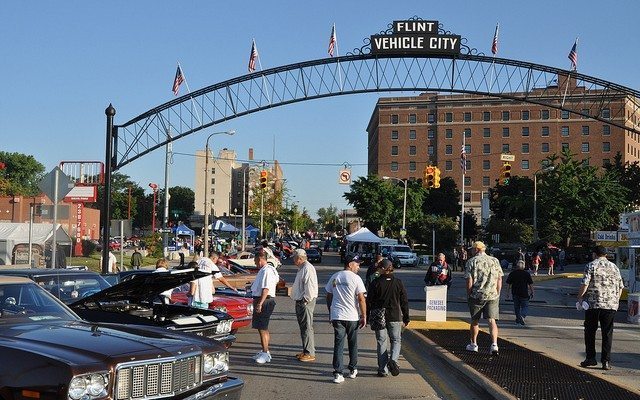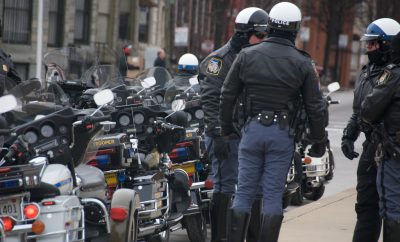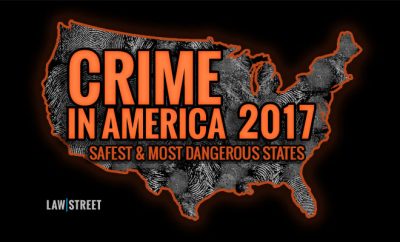
Crime
Crime in America: Top 10 Most Dangerous Cities Under 200,000
In the United States, there is a disproportionately high level of violent crime in densely populated areas; however, crime levels in similar size cities vary widely. This calls us to investigate what factors make certain cities safer or more dangerous than others. To properly compare and analyze these cities, we group them into large and small categories. A large city is considered to be one that has a population greater than 200,000 people. We then further adjust for population by ranking each city by its violent crime rate, which is the measure of how many violent crimes occurred per 100,000 people in 2012. Violent crime is defined by the total number of murders, aggravated assaults, robberies, and forcible rapes during the year. Although murder is included in the aggregate violent crime rate, we also report the murder rate separately for each city.
For additional information on Law Street’s crime-ranking methodology, click here.
Here are the 10 most dangerous small cities in the United States based on the FBI’s Uniform Crime Report Statistics released September 16, 2013:
1. Flint, Mich.
Flint, Michigan is the most dangerous city in America for the second year in a row. Flint had 2,729 violent crimes per 100,000 residents in 2012, which reflects a notable increase from 2,336 in 2011. The city also had the highest murder rate in 2012 with 61 murders occurring for every 100,000 residents.
Flint was once a productive manufacturing city, but was one of the worst victims of the automotive decline in America. As many local factories shut down and moved away, very little was done to attract new jobs and the city was left to decay. As a result, Flint’s population has dramatically declined, losing approximately 18 percent of its residents in the last 12 years. The unemployment rate in Flint in 2012 was 9.5 percent, and although that reflects a significant improvement from its peak at 14.5 percent in 2009, it remains very high relative to the national average. Additionally, Flint still has a low median income, which, according to the Census Bureau, is at almost half of the nationally determined poverty line. Arguably the largest contributor to crime in Flint is its extremely low number of police officers relative to its population. Flint ranks 218th in terms of officers per population among cities with over 100,000 residents, but first in terms of violent crime per population.
Violent Crime Rate: 2729.46 per 100,000 people Population: 101,632 Murder Rate: 61.99 per 100,000 people Officer to Population Ratio: 1: 854 Median Household Income: $26,621 Unemployment Rate: 9.5 percent Dangerous Small City Rank in 2011: #1
2. New Haven, Conn.
New Haven is the first of three Connecticut cities featured on our list of dangerous small cities. New Haven has frequently found itself listed as one of the most dangerous cities in America over the past several years, prompting officials to make policing changes. The police department has reported recent improvements in crime rates as well as community trust in officers due to increased presence and visibility. Although the New Haven police department has started to increase the number of patrolling officers to promote its new community oriented policing strategy, many believe that the economic inequality needs to be addressed before a reduction in crime can occur.
Violent Crime Rate: 1439.19 per 100,000 people Population: 129,934 Murder Rate: 13.08 per 100,000 people Officer to Population Ratio: 1: 561 Median Household Income: $39,094 Unemployment: 12.1 percent Dangerous Small City Rank in 2011: #4
3. Rockford, Ill.
Ranking number three on our list is Rockford, Illinois. Poverty is a major issue for the city, with a an unemployment rate of over 11 percent (though this represents a sharp decrease from a high of 19 percent in 2010). This may be the reason why Rockford has the second highest rate of aggravated assaults among small cities in the U.S., and the eighth highest among all cities with a population over 100,000. Its annual median household income is well below the poverty line, which the Census Bureau determined to be less than $50,052. With a disproportionately large amount of violent crime it is no surprise that Rockford is ranked number three on our list.
Violent Crime Rate: 1367.76 per 100,000 people Population: 152,293 Murder Rate: 5.91 per 100,000 people Officer to Population Ratio: 1: 561 Median Household Income: $38,864 Unemployment Rate: 11.4 percent Dangerous Small City Rank in 2011: #3
4. Hartford, Conn.
Like many other cities in Connecticut, gang violence in Hartford continues to be one of the major contributors to crime. According to an internal police report, gang activity has spread throughout the entire city, and has even begun reaching a large number of juveniles. An article on NBC’s Connecticut news site estimates that there are nearly 4,000 gang members in the city, 800 of whom are reportedly under the age of 17. Furthermore, there are nearly 140 different gangs in existence as of 2009, and although gangs vary in their contributions to crime, the numbers show that they are a very visible feature of the city.
Violent Crime Rate: 1321.85 per 100,000 people Population: 125,203 Murder Rate: 18.37 per 100,000 people Officer to Population Ratio: 1: 261 Median Household Income: $64,007 Unemployment Rate: 8.4 percent Dangerous Small City Rank in 2011: #5
5. Little Rock, Ark.
Little Rock has one of the highest murder rates in the country, ranking second among all of the small cities in the United States. With nearly 23 murders per 100,000 people, Little Rock has recently been experiencing serious problems. The city endured 10 murders in July 2012 alone, the most murders in a month since 1993. Following a 1994 HBO documentary on the city’s violent criminal activity, gang presence remains a major issue and cause for concern.
Violent Crime Rate: 1315.45 per 100,000 people Population: 196,055 Murder Rate: 22.95 per 100,000 people Officer to Population Ratio: 1: 520 Median Household Income: $44,392 Unemployment Rate: 6.5 percent Dangerous Small City Rank in 2011: #2
6. Bridgeport, Conn.
Bridgeport faces major street violence issues, prompting Mayor Bill Finche to sign a controversial ordinance instituting a curfew in order to crack down on crime. The mayor believes this will give the CTPD additional assistance in restricting local street violence. According to the mayor, most crime among the city’s youth occurs in the early evening, which is the time targeted by this new ordinance. Bridgeport is Connecticut’s largest city in terms of population, and its high level of gang activity reflects what appears to be a statewide problem.
Violent Crime Rate: 1205.23 per 100,000 people Population: 146,030 Murder Rate: 15.07 per 100,000 people Officer to Population Ratio: 1: 353 Median Household Income: $40,947 Unemployment Rate: 7.8 percent Dangerous Small City Rank in 2011: #11
7. Richmond, Calif.
Richmond, California, ranking number seven on our list, has recently increased investment in its police force; however, crime continues to rise in the area. Despite the increase in public safety spending, Richmond still lags behind most cities on this list in terms of officer to population ratio. The Richmond police have also faced significant issues with clearing murder cases, which may be influenced by the high level of gang presence and violence in the city.
Violent crime rating: 1092.55 per 100,000 people Population: 106,357 Murder Rate: 16.92 per 100,000 people Officer to Population Ratio: 1: 182 Median Household Income: $54,554 Unemployment: 14.6 percent Dangerous Small City Rank in 2011: #13
8. Odessa, Texas
Although Odessa has the lowest unemployment rate among the cities on this list, its police department has been facing several personnel and funding issues. With only one officer for every 709 residents, Odessa’s police force is undermanned compared to many cities of similar size. Recent requests for additional officers have been rejected due to budgetary constraints, preventing the city from reaching its goal of two officers for every 1,000 people.
Violent Crime Rate: 1064.31 per 100,000 people Population: 103,635 Murder Rate: 4.82 per 100,000 Police Officer to Population Ratio: 1: 709 Median Household Income: $50,813 Unemployment: 4.2 percent Dangerous Small City Rank in 2011: #34
9. Paterson, N.J.
Paterson’s crime level is considered by many to be a result of the city’s high level of poverty, unemployment and gang violence. Paterson is also one of the more prominent victims of industrial decay, as the once working class city has continued to decline over the past several decades. There seems to be a very strong connection between Paterson’s economic decline and high crime rate, further indicating that unless its economy is able to rebound, the level of crime in Paterson is unlikely to improve. Additionally, many community members blame the local education system, which they believe needs to be improved in order to curtail gang activity and youth violence.
Violent Crime Rate: 1054.72 per 100,000 people Population: 147,148 Murder Rate: 14.27 per 100,000 people Officer to Population Ratio: 1: 371 Median Household Income: $34,301 Unemployment: 16.5 percent Dangerous Small City Rank in 2011: #10
10. Springfield, Mass.
Rounding out the list is Springfield, Massachusetts, which, according to the FBI, has the 10th highest level of violent crime per capita among small cities in the United States. Springfield’s high levels of violent crime and gang activity have lead its police department to adopt Iraq-style “counterinsurgency” strategy. This strategy involves community building in which officers work to solve the underlying problems that contribute to crime. Increased police visibility has also been used to help combat issues with gangs in an attempt to make Springfield residents feel more secure. Although many members of the local police department believe these strategies will help, the jury is still out on the effect of the these new efforts and Springfield remains one of the most dangerous American cities in 2012. Violent Crime Rate: 1039.36 per 100,000 people Population: 154,518 Murder Rate: 7.12 per 100,000 people Officer to Population Ratio: 1:420 Median Household Income: $52,762 Unemployment Rate: 7.9 percent Dangerous Small City Rank in 2011: #9
Research and analysis by Law Street’s Crime in America Team: Kasandra Cisneros, Valeriya Metla, Asim Mian, and Kevin Rizzo.
Sources:
Violent crime, population, murder, and officer statistics are from the FBI 2012 Uniform Crime Report
Median household income is measured from 2007-2011, and is from the U.S. Census Bureau
Unemployment rate statistics come from 2012 data compiled by the U.S. Bureau of Labor Statistics
Click here for FBI data on each of the cities ranked above. Click here for all Law Street crime data.
Click here for additional information on Law Street’s crime-ranking methodology.
Click here to read more Crime in America coverage.
Featured image courtesy of [Michigan Municipal League via Flickr]









Comments